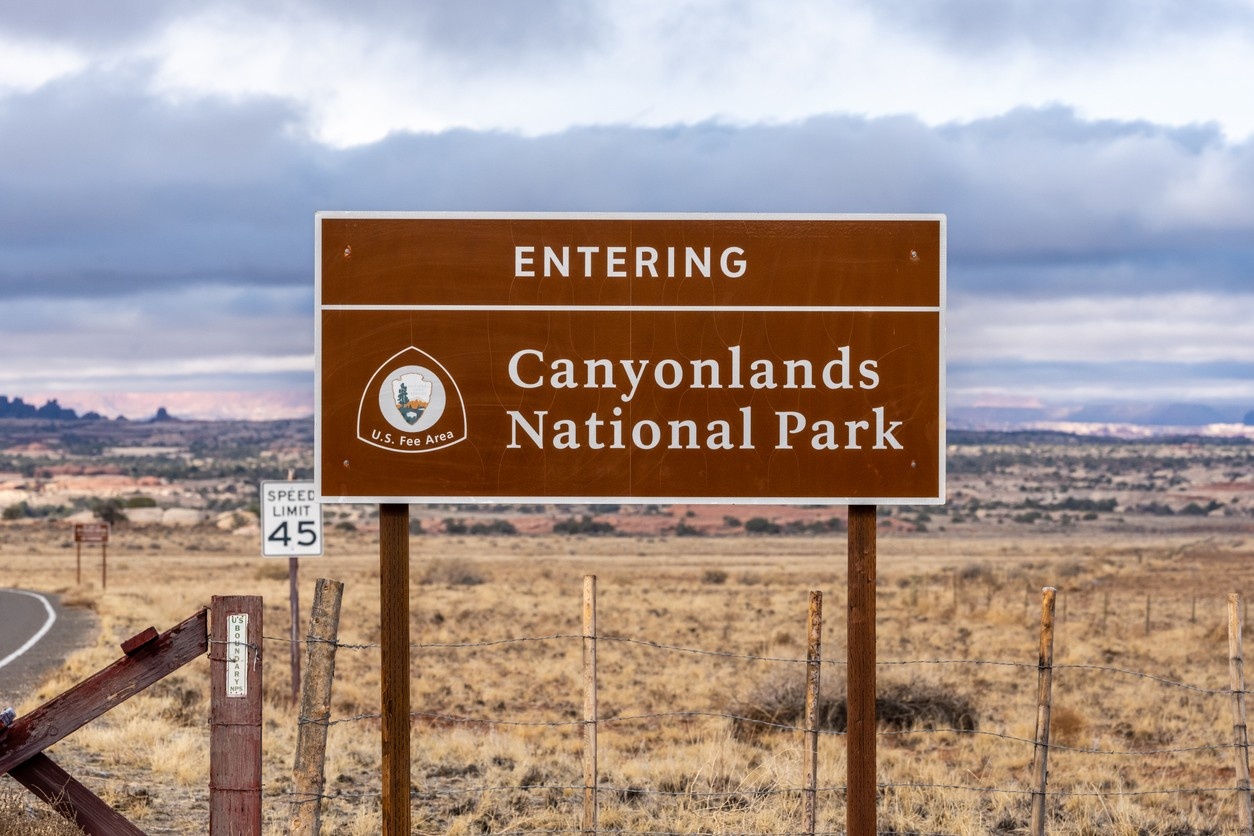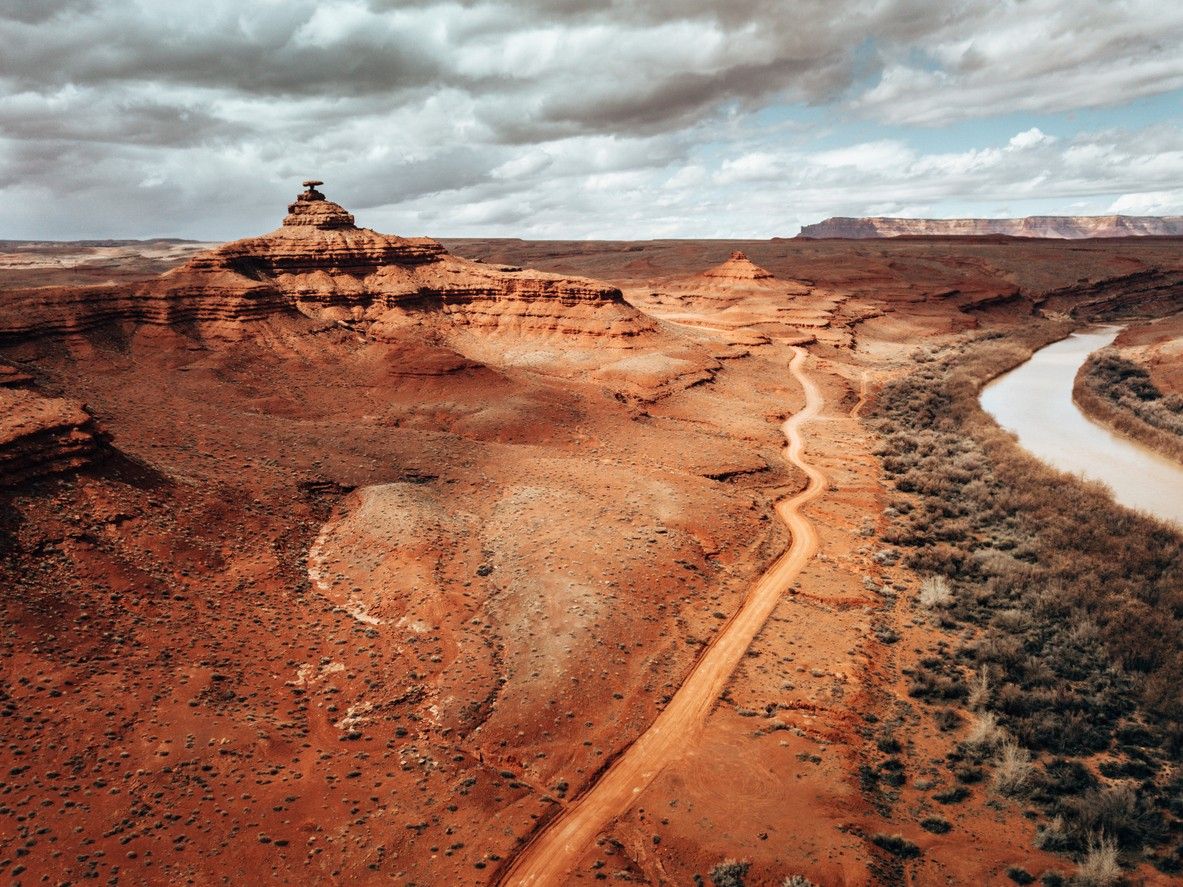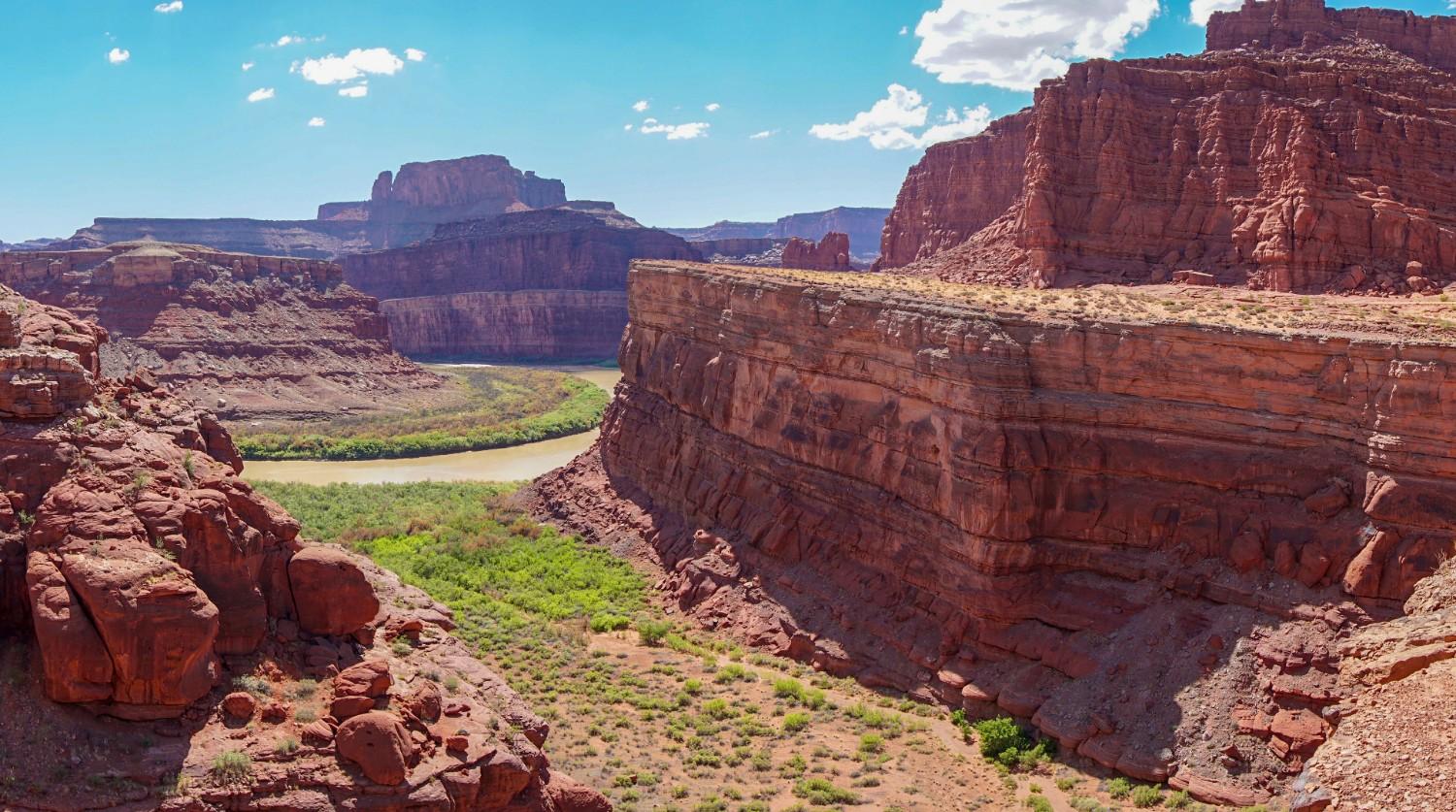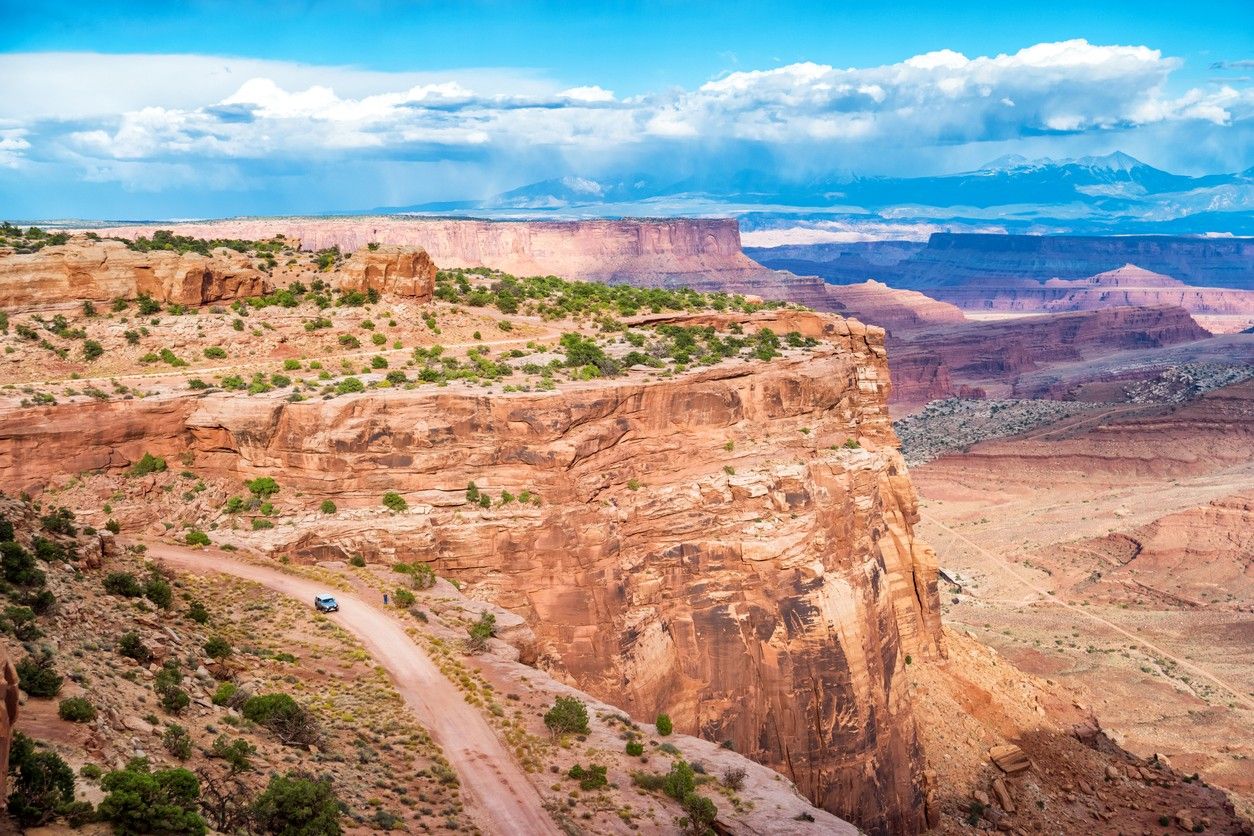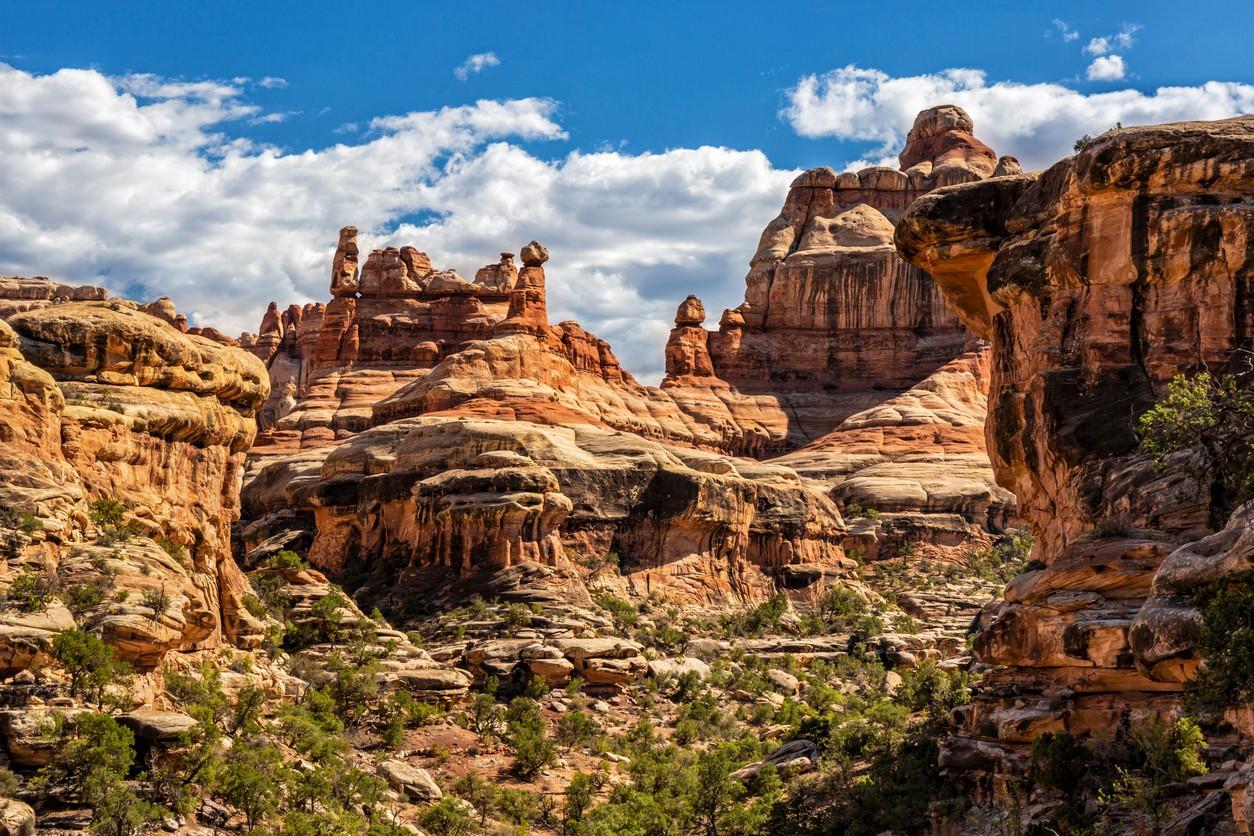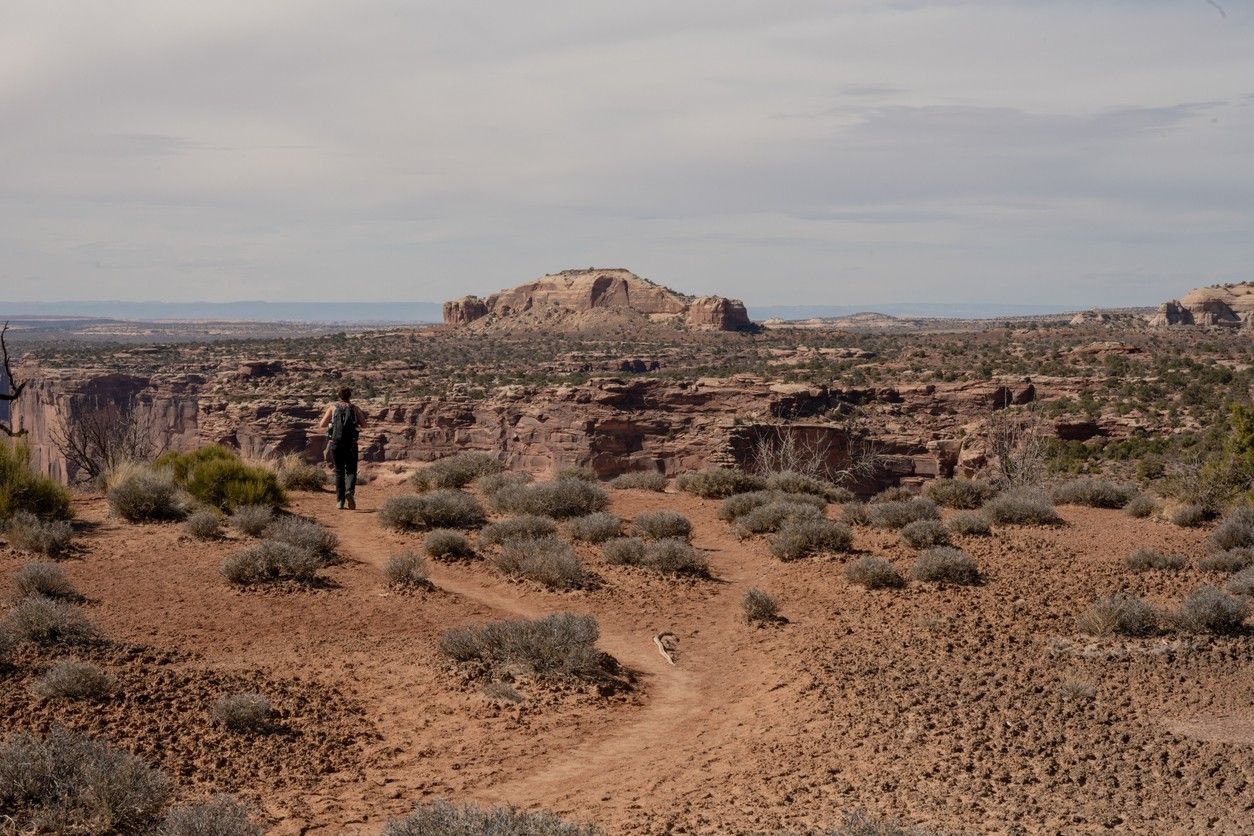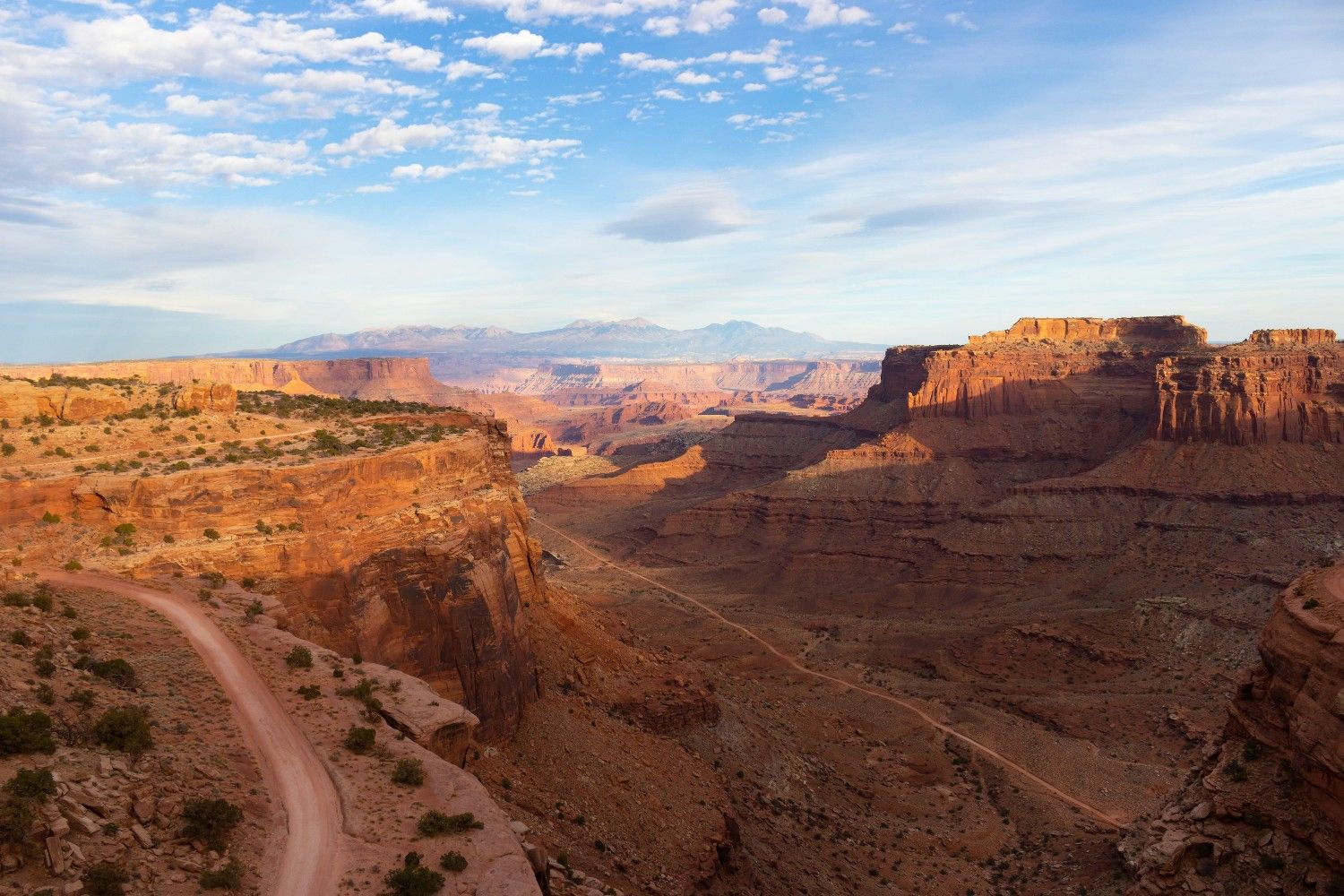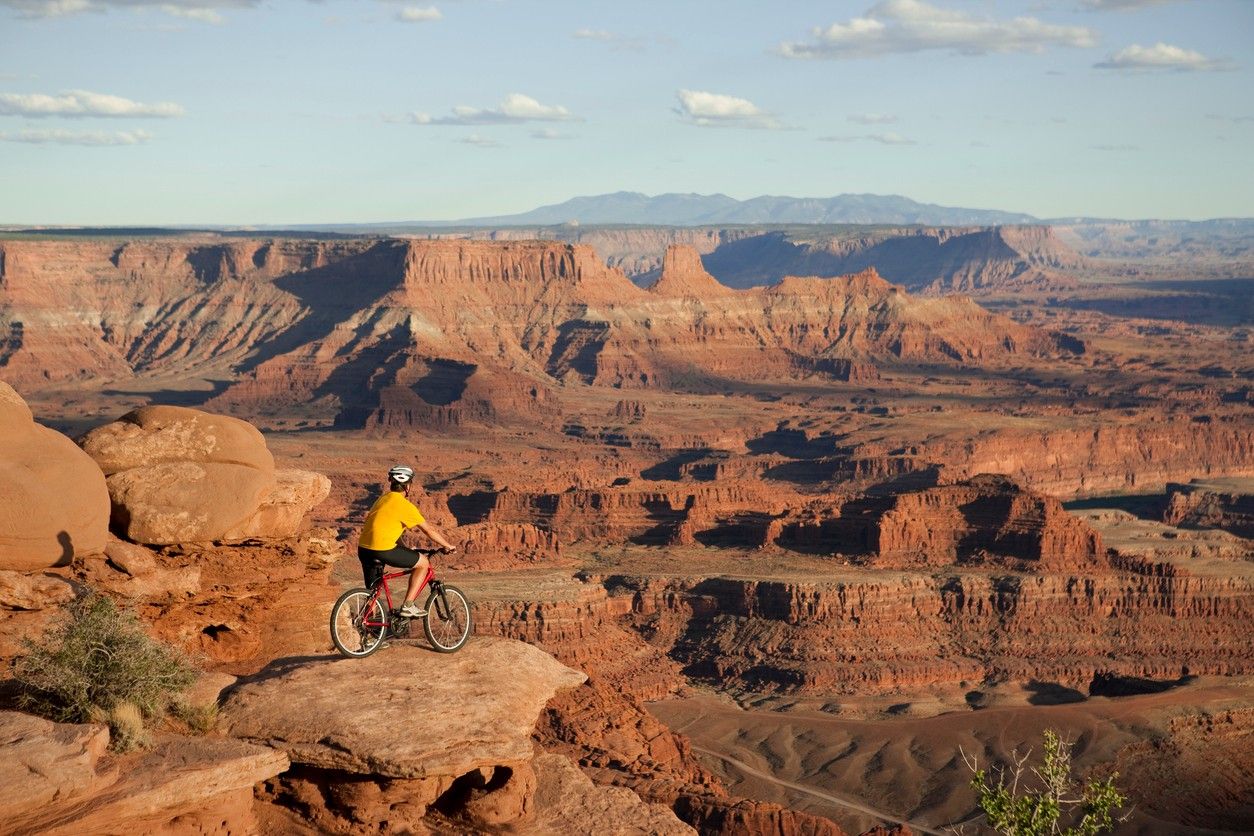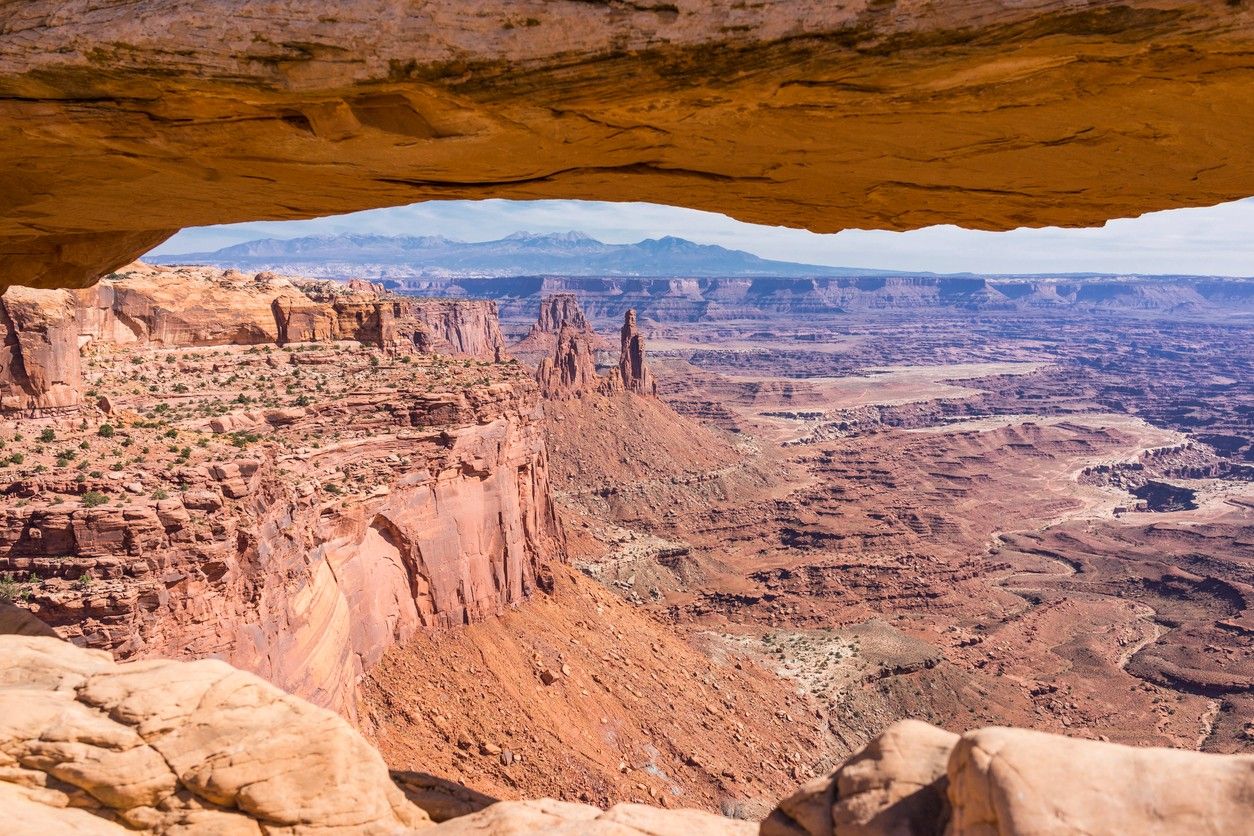Canyonlands National Park spans an immense 527 square miles of rugged desert landscape in southeastern Utah, USA. Carved over millions of years by the relentless forces of the mighty Colorado River and its tributaries, this natural wonder features a kaleidoscope of towering sandstone cliffs, deep canyons, mesas, buttes, and seemingly endless vistas that stretch as far as the eye can see. A true geological masterpiece, Canyonlands showcases the power of erosion, with the rivers methodically sculpting the landscape into a labyrinth of intricate formations, sculpted fins, and serpentine waterways. The park's distinctive orange and red hues, formed by the oxidation of iron minerals in the ancient rock layers, create a visually stunning contrast against the deep blue desert skies.
Canyonlands National Park is divided into four distinct districts, each offering unique experiences and breathtaking scenery for outdoor enthusiasts. The Island in the Sky District, a broad mesa resting over 1,000 feet above the surrounding terrain, is renowned for its panoramic viewpoints and scenic drives that unveil the park's grandeur from a bird's-eye perspective. The Needles District, named for its striking sandstone spires and pinnacles, showcases a diverse array of hiking trails, rock climbing routes, and ancient rock art left behind by the Ancestral Puebloan people who once called this region home. The Maze District, encompassing 30 per cent of the park's area, is the most remote and rugged section, renowned for its intricate labyrinth of winding canyons, towering buttes, and challenging four-wheel-drive routes that lead adventurous explorers deep into the heart of the wilderness. Finally, the Colorado and Green Rivers District encompasses the very waterways that carved the canyons over millions of years, offering unparalleled opportunities for river rafting, kayaking, and fishing along the banks of these iconic waterways.
The Island in the Sky District
Covering an area of 36 square miles, the Island in the Sky District is a broad mesa resting over 1,000 feet above the surrounding terrain. Renowned for its breathtaking panoramic views, this region is a must-visit for photographers and sightseers alike.
Scenic Drives and Viewpoints
The Island in the Sky District offers several spectacular scenic drives that unveil the grandeur of Canyonlands National Park from multiple vantage points. These paved routes wind along the edges of the mesa, providing breathtaking overlooks and pull-outs that allow visitors to take in the vast, panoramic vistas. This 34-mile round-trip journey is the main scenic drive within the Island in the Sky District. Starting from the visitor centre, the road follows the mesa's edge, offering numerous overlooks and pull-outs along the way. Highlights include:
Grand View Point — At an elevation of 6,285 feet, this iconic viewpoint provides sweeping vistas of the park's maze of canyons, buttes, and the White Rim Road below.
Green River Overlook — This overlook offers a bird's-eye view of the Green River as it winds its way through the park, cutting through towering cliffs and forming oxbow bends.
Upheaval Dome — This unique geological feature resembles a crater but is believed to be the result of salt domes pushing up the overlying rock layers. A short trail leads to an overlook with interpretive signs explaining the formation's origins.
Whale Rock — This massive sandstone formation, shaped like a breaching whale, is a popular stop along the scenic drive, offering excellent photographic opportunities.
Shafer Trail Viewpoint — Accessible via a spur road off the Island in the Sky Scenic Drive, the Shafer Trail Viewpoint provides a dramatic perspective of the Shafer Trail switchbacks as they descend from the mesa top to the White Rim Bench below.
Upheaval Dome Overlook — In addition to the overlook along the main scenic drive, a side road leads to the Upheaval Dome Overlook, offering a different vantage point of this fascinating geological formation.
Hiking Trails
While the Island in the Sky District is renowned for its scenic drives and viewpoints, it also offers several hiking trails that allow visitors to immerse themselves in the park's rugged beauty up close. These trails range from short, easy walks to strenuous, all-day treks, catering to hikers of all skill levels.
Aztec Butte Trail (2 miles round-trip) — This moderately strenuous hike leads to the top of a butte, offering panoramic views of the Island in the Sky mesa and the surrounding canyons.
Mesa Arch Trail (0.5 miles round-trip) — A short, flat trail that leads to the iconic Mesa Arch, a stunning rock formation that frames a perfect view of the Buck Canyon Overlook.
Upheaval Dome Trail (1.8 miles round-trip) — This loop trail takes hikers along the rim of the Upheaval Dome, providing a closer look at this unique geological feature and offering excellent opportunities for spotting desert wildlife.
Neck Spring Trail (5.8 miles round-trip) — This moderate hike descends into the canyon below the Island mesa, leading to a small spring and offering a different perspective on the park's towering rock formations.
Syncline Loop (8.4 miles round-trip) — A challenging hike that traverses a variety of terrain, including Slickrock, sandy washes, and narrow canyons, offering solitude and stunning vistas.
Gooseberry Trail (5.4 miles one-way) — This strenuous point-to-point hike connects the Island in the Sky District with the Needles District, providing a unique opportunity to experience both regions on foot.
In addition to these designated trails, the Island in the Sky District also offers opportunities for off-trail exploration and route-finding for experienced hikers. However, it's essential to exercise caution, carry plenty of water, and obtain a backcountry permit from the park's visitor centre before embarking on such adventures.
Camping and Stargazing
For those seeking an immersive experience in the heart of Canyonlands National Park, the Island in the Sky District offers camping opportunities that blend outdoor adventure with stunning natural beauty and stargazing like no other.
Willow Flat Campground — Located amidst a grove of juniper and pinyon pine trees, the Willow Flat Campground is the only developed campground within the Island in the Sky District. With 12 individual sites and a group site, this campground provides basic amenities such as picnic tables, fire rings, and vault toilets. While the campsites are relatively close together, the surrounding landscape offers a sense of seclusion and tranquillity. The campground's central location makes it an ideal base camp for exploring the Island in the Sky District's scenic drives, viewpoints, and hiking trails. Reservations for Willow Flat Campground are recommended, especially during peak seasons, as sites fill up quickly. Campers should be prepared with adequate water, food, and supplies, as there are no services available within the campground.
Backcountry Camping — For those seeking a more remote and primitive camping experience, the Island in the Sky District offers backcountry camping opportunities. Permits are required for overnight stays in the backcountry, and campers must follow strict regulations to minimise their impact on the fragile desert environment. Backcountry camping allows visitors to truly immerse themselves in the wilderness, with opportunities to witness breathtaking sunrises and sunsets and experience the park's incredible dark skies and stargazing opportunities.
Stargazing — With its remote location and minimal light pollution, the Island in the Sky District is renowned for its exceptional stargazing conditions. The Willow Flat Campground and various viewpoints along the scenic drive offer unobstructed views of the night sky, making them prime locations for stargazing and astrophotography. During new moon periods, the Milky Way Galaxy is visible in all its glory, stretching across the vast expanse of the night sky. Meteor showers, planetary alignments, and other celestial events can be observed and captured with remarkable clarity from the Island in the Sky District.
The Needles District
Named for its striking sandstone spires and pinnacles, the Needles District covers 100 square miles and showcases a diverse array of geologic formations, hiking opportunities, and ancient rock art.
Hiking Trails
The Needles District is a hiker's paradise, boasting over 60 miles of interconnected trails that wind through towering sandstone spires, narrow canyons, and diverse landscapes. From short, family-friendly hikes to strenuous multi-day treks, this area offers something for all skill levels and interests.
Pothole Point Trail (0.6 miles round-trip) — This easy trail leads to a viewpoint overlooking colourful sandstone potholes and offering vistas of the Needles formations.
Cave Spring Trail (0.6 miles round-trip) — A gentle hike that takes visitors to an oasis-like setting with a small spring and opportunities to spot desert wildlife.
Slickrock Trail (2.4 miles round-trip) — A moderately challenging loop that traverses across slick rock formations, providing up-close views of the Needles and surrounding rock sculptures.
Chesler Park Loop Trail (11 miles round-trip) — This strenuous hike is one of the park's most iconic, taking hikers through a stunning amphitheatre of sandstone spires, fins, and hoodoos in the heart of the Needles District.
Druid Arch Trail (10.4 miles round-trip) — A challenging trek that leads to the impressive Druid Arch, a striking sandstone formation that spans over 200 feet.
Elephant Canyon Trail (10.8 miles round-trip) — This strenuous hike follows a narrow canyon, passing by towering walls, boulder jams, and the iconic Elephant Butte formation.
Salt Creek Canyon — This popular backpacking route follows a narrow, winding canyon, offering opportunities to explore ancient rock art, cottonwood groves, and natural arches along the way. Permits are required for overnight stays.
Squaw Canyon/Squaw Flat Loop — A challenging multi-day loop that combines the Squaw Canyon and Squaw Flat areas, showcasing diverse landscapes and geological features. Advanced route-finding skills are essential.
Ancient Rock Art
The Needles District of Canyonlands National Park is a treasure trove of ancient rock art, left behind by the Ancestral Puebloan people who inhabited this region centuries ago. These remarkable petroglyphs and pictographs offer a fascinating glimpse into the rich cultural heritage of the area and provide a unique opportunity for visitors to connect with the past. One of the most accessible and well-preserved examples of ancient rock art in the Needles District can be found along the Roadside Ruin Trail. This short, 0.6-mile round-trip hike leads to a granary structure and an impressive rock art panel, showcasing intricate carvings and paintings on the sandstone cliffs. The Roadside Ruin Trail begins near the Squaw Flat Campground and is suitable for hikers of all skill levels. As you approach the rock art panel, you'll be greeted by a variety of figures, including anthropomorphic (human-like) and zoomorphic (animal-like) forms, as well as abstract designs and symbols.
While the exact meanings of these ancient carvings and paintings are not always clear, they are believed to have played a significant role in the religious and cultural practices of the Ancestral Puebloan people. Some of the images may depict hunting scenes, sacred ceremonies, or celestial events. In addition to the Roadside Ruin Trail, other areas within the Needles District, such as Chesler Park and Lost Canyon, also contain rock art panels that can be accessed by longer, more strenuous hikes. Visitors are advised to consult with park rangers or obtain a hiking map to locate and properly access these sites.
Rock Climbing and Canyoneering
The Needles District is a mecca for rock climbers and canyoners, offering a diverse array of challenges and stunning landscapes. From towering sandstone spires to narrow slot canyons, this area provides endless opportunities for adventure seekers.
Rock Climbing:
Chesler Park — This expansive amphitheatre is renowned for its world-class crack climbing routes, with pitches ranging from beginner to expert levels. The striking sandstone formations and unique rock features make this area a must-visit for climbers.
The Needles — As the namesake of the district, these towering sandstone spires offer a variety of traditional and sport climbing routes, showcasing the area's incredible geology.
The Grabens — This complex series of parallel canyons and ridges features a variety of challenging multi-pitch climbs, including routes that ascend through narrow slots and chimneys.
Canyoneering:
Elephant Canyon — This narrow, winding canyon requires a combination of hiking, scrambling, and technical rope work to navigate its obstacles, including boulder jams and pour-offs.
Lost Canyon — A remote and challenging slot canyon that features several rappels, downclimbs, and swim sections, making it a true adventure for experienced canyoners.
Cyclone Canyon — With its twisting narrows and technical obstacles, this canyon offers a thrilling and demanding canyoneering experience, requiring advanced skills and proper equipment.
Before embarking on any rock climbing or canyoneering adventures in the Needles District, it's essential to obtain the necessary permits, hire a licensed guide (if needed), and have the appropriate skills, gear, and safety equipment. The park's remote location and rugged terrain demand careful preparation and adherence to safety protocols. Additionally, climbers and canyoners must follow strict Leave No Trace principles to minimise their impact on the fragile desert environment, ensuring that future generations can continue to enjoy the beauty and challenges of this remarkable area.
The Maze District
Encompassing 30 per cent of Canyonlands National Park, the Maze District is the most remote and rugged section, renowned for its intricate labyrinth of winding canyons, towering buttes, and endless solitude.
Four-Wheel Drive Routes
The Maze District of Canyonlands National Park is one of the most remote and rugged areas in the entire park system, accessible only by high-clearance, four-wheel-drive vehicles due to the challenging terrain and lack of maintained roads. These off-road routes offer adventurous drivers an unparalleled opportunity to explore the park's vast wilderness and stunning geological formations.
The Flint Trail — The Flint Trail is the primary four-wheel-drive route through the Maze District, covering approximately 48 miles of rough, unpaved terrain. This challenging trail winds through a maze of canyons, over rocky outcrops, and across sandy washes, providing access to some of the park's most remote and breathtaking landscapes. Along the Flint Trail, drivers will encounter iconic features such as the Chocolate Drops, a series of towering sandstone buttes, and the Doll House, a cluster of intricate rock formations that resemble miniature buildings. The trail also offers glimpses of ancient Puebloan granaries and rock art sites, adding a cultural element to the rugged adventure. The Flint Trail requires a high-clearance, four-wheel-drive vehicle with aggressive tyres, as well as experienced off-road driving skills. Obstacles such as steep grades, rocky sections, and deep sand can be encountered, making it a challenging and potentially hazardous route for inexperienced drivers.
Other Four-Wheel Drive Routes:
In addition to the Flint Trail, the Maze District offers several other four-wheel-drive routes for experienced off-roaders, including:
The Maze Overlook Trail — A challenging 5.5-mile round-trip hike that provides stunning vistas of the Maze District without the need for a four-wheel-drive vehicle.
The Elephant Hill Road — A rugged, 6-mile route that follows the western rim of the Maze District, offering scenic overlooks and access to remote hiking trails.
The Hart Point Road — A remote and challenging 4-wheel-drive trail that leads to Hart Point, a viewpoint overlooking the Needles District and the Colorado River.
Proper planning, equipment, and safety precautions are essential when exploring the Maze District via four-wheel-drive routes. Drivers should carry ample supplies, including water, food, and emergency gear, as well as obtain detailed maps and familiarise themselves with the area before embarking on their adventure.
Backpacking and Canyoneering
For the most adventurous and experienced outdoor enthusiasts, the Maze District offers unparalleled opportunities for multi-day backpacking and canyoneering expeditions. These remote and rugged adventures allow visitors to truly immerse themselves in the heart of Canyonlands National Park's wilderness, exploring areas seldom seen by the average visitor.
Backpacking — The Maze District is a prime destination for backcountry backpacking, with several multi-day routes traversing the intricate network of canyons, mesas, and buttes. Some popular backpacking routes include:
The Maze Overlook Trail — This strenuous 25-mile loop combines the Flint Trail and the Maze Overlook Trail, offering stunning vistas and opportunities to explore remote canyons and rock formations.
The Harvest Scene Trail — A challenging 26-mile route that winds through a maze of canyons, including the iconic Harvest Scene and Doll House formations.
The Chesler Park Loop — While primarily located in the Needles District, this 11-mile loop can be extended into the Maze District for a multi-day backpacking adventure.
Canyoneering — The Maze District is a mecca for advanced canyoneers, with its labyrinth of narrow slot canyons, technical obstacles, and remote locations. Some of the most popular and challenging canyoneering routes include:
The Chocolate Drops — This demanding route involves navigating through a series of narrow slots, rappelling down pour-offs, and squeezing through tight spaces within the iconic Chocolate Drops formation.
The Doll House — A highly technical canyoneering adventure that requires rappelling, downclimbing, and navigating through the intricate rock formations of the Doll House area.
Lost Canyon — A remote and challenging slot canyon that features several rappels, downclimbs, and swim sections, requiring advanced canyoneering skills and proper equipment.
Permits are required for both backpacking and canyoneering in the Maze District, and visitors must adhere to strict Leave No Trace principles to minimise their impact on the fragile desert environment. Proper planning, navigation skills, and self-sufficiency are essential, as rescue operations in this remote area can be extremely difficult and time-consuming.
The Colorado and Green Rivers District
The Colorado and Green Rivers played a pivotal role in shaping the landscape of Canyonlands National Park, carving the massive canyons and rock formations over millions of years.
River Rafting and Kayaking
The Colorado and Green Rivers, which carved the stunning canyons of Canyonlands National Park over millions of years, offer visitors a unique and thrilling way to experience the park's natural beauty – from the waterways themselves. River rafting and kayaking trips along these iconic rivers provide an intimate and unforgettable perspective of the towering canyon walls, hidden side canyons, and diverse ecosystems that line the riverbanks. For those seeking a fully outfitted and guided adventure, several authorised outfitters offer multi-day rafting trips along the Colorado and Green Rivers. These trips typically range from 3 to 7 days and include all necessary equipment, meals, and experienced guides who provide invaluable knowledge and expertise about the park's geology, history, and ecology. Rafting trips often begin in the town of Green River or Moab and traverse stretches of the Colorado River, passing through iconic landmarks such as Cataract Canyon, the Confluence of the Green and Colorado Rivers, and the Goosenecks of the San Juan River. Along the way, rafters can witness stunning rock formations, ancient petroglyphs, and a variety of wildlife, including bighorn sheep, great blue herons, and river otters.
Kayaking and canoeing trips along the Colorado and Green Rivers offer a unique perspective of the park's waterways. These trips require advanced paddling skills, as well as proper equipment and safety gear, as the rivers can be challenging and unpredictable, with rapids ranging from Class I to Class V. Kayakers and canoeists can choose to embark on day trips or multi-day expeditions, camping along the riverbanks and exploring side canyons and tributaries that are inaccessible by larger rafts. These adventures offer a sense of solitude and connection with the natural environment, as paddlers navigate the winding waterways and witness the ever-changing landscapes of Canyonlands National Park.
Camping and Fishing
Along the banks of the Colorado and Green Rivers, Canyonlands National Park offers a variety of camping opportunities, allowing visitors to fully immerse themselves in the park's natural beauty and tranquillity. These designated campsites provide a serene setting for overnight stays, with the soothing sounds of flowing water and the opportunity to witness stunning sunrises and sunsets.
Riverside Campsites — Several designated campsites are located along the Colorado and Green Rivers, accessible by water or by hiking in from nearby trailheads. These sites offer basic amenities such as fire rings, tent pads, and vault toilets, but no potable water or other services. Campers must obtain a backcountry permit from the park's visitor centres and follow strict Leave No Trace principles to minimise their impact on the fragile desert environment. Camping along the rivers allows visitors to truly disconnect from the modern world and immerse themselves in the park's natural rhythms and sounds.
Fishing Opportunities — The Colorado and Green Rivers are home to a variety of fish species, including trout, bass, catfish, and carp, making them a prime destination for anglers. Both rivers offer excellent fishing opportunities, with some of the best spots located near the confluence of the two waterways and in the calm stretches downstream from rapids. A Utah fishing license is required for all anglers, and catch-and-release practices are encouraged to help maintain healthy fish populations. Fly fishing and spin casting are popular techniques, and anglers can expect to encounter a variety of challenging currents and structures that test their skills.
When to Visit
While Canyonlands National Park is open year-round, the best time to visit depends on individual preferences and desired activities.
Spring and Fall — Spring (April to May) and fall (September to October) are often considered the ideal seasons for visiting Canyonlands. During these months, temperatures are mild, ranging from the 60s to 80s Fahrenheit (15-30°C), making outdoor activities more comfortable. Additionally, the park is typically less crowded during these shoulder seasons, allowing for a more peaceful and serene experience.
Summer — Summer (June to August) in Canyonlands can be extremely hot, with temperatures frequently exceeding 100°F (38°C). While this season may not be ideal for strenuous hiking or camping, early morning and evening hours can be pleasant for exploring the park's scenic drives and viewpoints. It's important to carry plenty of water, seek shade, and take necessary precautions during the intense midday heat.
Winter — Winters in Canyonlands are generally mild, with daytime temperatures ranging from the 40s to 60s Fahrenheit (5-15°C). While some areas of the park may experience snow and ice, the Island in the Sky District and the Needles District are often accessible year-round. Winter can be an excellent time for hiking, photography, and stargazing, with fewer crowds and the bonus of possible snow-dusted landscapes.
Planning Your Visit
To make the most of your Canyonlands National Park experience, proper planning and preparation are essential. Here are some key considerations:
Park Entry Fees — As with most national parks, Canyonlands charges an entry fee. A 7-day pass for private vehicles is currently $30, while individual hikers and cyclists pay $15 per person. Annual passes and other options are available, so be sure to check the park's website for the latest pricing and information.
Lodging and Camping — While there are no lodges or hotels within the park itself, several gateway communities, such as Moab, offer a range of accommodation options, from hotels and motels to vacation rentals. For those seeking a more immersive experience, camping is available in designated campgrounds within the park, including Willow Flat in the Island in the Sky District and Squaw Flat in the Needles District. Reservations are recommended, especially during peak seasons.
Transportation and Fuel — With the park's vast size and remote areas, having a reliable vehicle with high clearance and four-wheel drive capabilities is recommended, especially if you plan to explore the Maze District or venture onto unpaved roads. Fuel stations are limited within the park, so it's advisable to fill up in nearby towns like Moab or Green River before embarking on your adventure.
Guided Tours and Permits — For certain activities, such as river rafting, canyoneering, and rock climbing, it's recommended to hire a licensed guide or obtain the necessary permits. Guides can provide valuable expertise, equipment, and knowledge of the area, ensuring a safe and enjoyable experience. Permits are required for activities like overnight backpacking trips and climbing in specific areas.
Water and Supplies — With its desert environment, carrying plenty of water and supplies is crucial when exploring Canyonlands National Park. Dehydration and heat-related illnesses are real risks, so pack more water than you think you'll need, along with snacks, sun protection, and proper footwear.
Leave No Trace — As with any natural area, it's essential to practice Leave No Trace principles when visiting Canyonlands National Park. This includes packing out all trash, respecting wildlife, staying on designated trails, and leaving cultural and natural resources undisturbed for future generations to enjoy.
Related articles

Let us know you agree to cookies
We use marketing, analytical and functional cookies as well as similar technologies to give you the best experience. Third parties, including social media platforms, often place tracking cookies on our site to show you personalised adverts outside of our website.
We store your cookie preferences for two years and you can edit your preferences via ‘manage cookies’ or through the cookie policy at the bottom of every page. For more information, please see our cookie policy.

